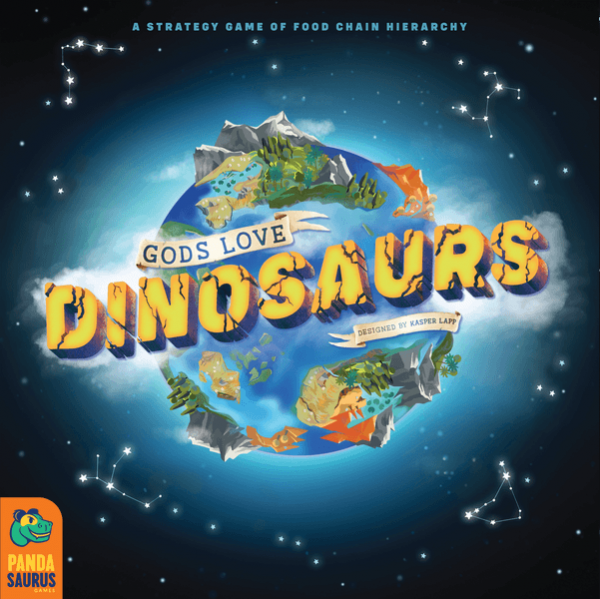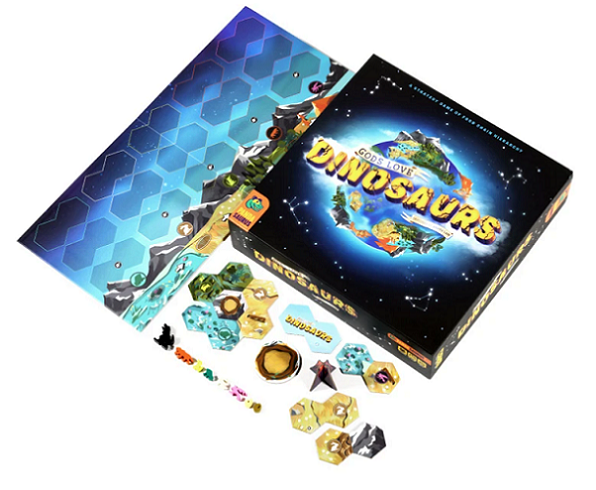Create Your Own Animal-Filled World in Gods Love Dinosaurs

You are making your very own planet, full of animals. But secretly the only animal you’re interested in is the mighty dinosaur. Can you fill your world with the most dinosaurs and still have enough food to sustain them?
Gods Love Dinosaurs, published by Pandasaurus Games, has players trying to balance the prey, predators, and dinosaurs of their worlds so as to be able to sustain life while also filling it with dinosaurs. A unique theme, to be sure — but how does it play?
Gameplay
Each player starts the game with a starting tile that shows six ecosystem hexagons. The center hexagon is a mountain space, and each player places a dinosaur here. Each player also places a rabbit, a frog, and a rat on marked hexagons on their starting tile and starts the game with three dinosaur eggs.
The animal board is placed in the center of the table. The animal board shows five columns, with each column associated with one of five animals. At the bottom of the board a dinosaur token is placed on the leftmost column. Each column is filled with two or three tiles, depending on player count. Each tile is made up of two ecosystem hexagons. There are three types of ecosystems, plus mountains and wilds.
On your turn you take one tile from the animal board and add it to your planet, so that at least one side of it touches one hexagon already placed. If there is an animal symbol on one of the newly placed hexagons, you place the indicated animal meeple on it.
When a column on the animal board runs out, all players activate the animal associated with that column. If it is one of the prey animals (rabbit, frog, or rat) this means for each animal of that type you have on the board you may place an additional one if there is an empty ecosystem space adjacent to it of that animal’s preferred ecosystem-type. When a predator activates (tiger or eagle), you may move it up to a certain number of hexes, and it will eat any prey it passes through and lands on. A predator must eat at least one prey or else it starves and is removed — for each additional prey it eats, an additional predator is spawned. A predator cannot move through a space with another predator or end its movement on a space with another animal.
Once the column on the animal board is empty that the dinosaur meeple is beneath, first the animal activates and then all dinosaurs activate. When dinosaurs activate, each player may first choose to discard a dinosaur egg in order to place a dinosaur on the starting mountain tile. Then each dinosaur can move up to five hexagons. It must eat at least one animal and end its movement on an empty mountain space, otherwise it starves and is removed from the board. A dinosaur will eat any animal it passes over, and for each predator it eats you will earn one dinosaur egg. Once the dinosaurs are done activating you refill any empty columns on the animal board and move the dinosaur to the next column. The dinosaur will continue to move back and forth between the columns throughout the game.
The game ends once there are no more tiles to refill the animal board with. Players earn one point for each dinosaur egg they have and one point for each dinosaur on the planets. The player with the most points wins.

Review
Gods Love Dinosaurs is an interesting puzzle about balancing your resources and occasionally taking risks and hoping the right tiles will turn up. When other players will activate animals and which tiles will be available on your turn is always unpredictable, so you have to balance how safe you play it with the risks you take.
The interaction between prey and predators, and predators and dinosaurs, leads to some tough choices, as does choosing when to hatch a new dinosaur. If your dinosaur doesn’t starve, it is worth the same number of points as an egg at the end of the game and can potentially make more eggs for you, but if it starves you just lost that point.
We liked the simple, straightforward scoring system. Each egg and dinosaur is worth a point. There are no private scoring goals or bonuses — this makes the game refreshingly easy to start playing while knowing what you’re supposed to be doing, without taking anything away from the game’s core puzzle.
Outside of other players causing animals and dinosaurs to activate, there isn’t really any player interaction, as each player is essentially working on their own puzzle. However, you can to some extent force animal activations when it is most inconvenient for an opponent, especially with the predators, and having to account for this unpredictability does add an extra layer to the game’s puzzle.
The game could really use player aid cards, showing how far each predator can move and each prey’s preferred ecosystem. It’s important to keep this information in mind for each tile you lay, so it slows down the game when you’re first learning it, to keep consulting the rulebook. Even in the rulebook this information is not all in one convenient location. However, the game’s component quality is excellent, especially the animal meeples for each species.
For players who enjoy tile-laying puzzles, Gods Love Dinosaurs is a great addition to the genre. The food chain-based gameplay is both challenging and intriguing, and the game length feels just about right. Also, between the animal activations and needing time to figure out paths for predators and dinosaurs, the downtime between your turns never feels onerous.
Pros: Intriguing puzzle, great component quality, straightforward scoring system
Cons: Limited player interaction, lack of player aid cards







